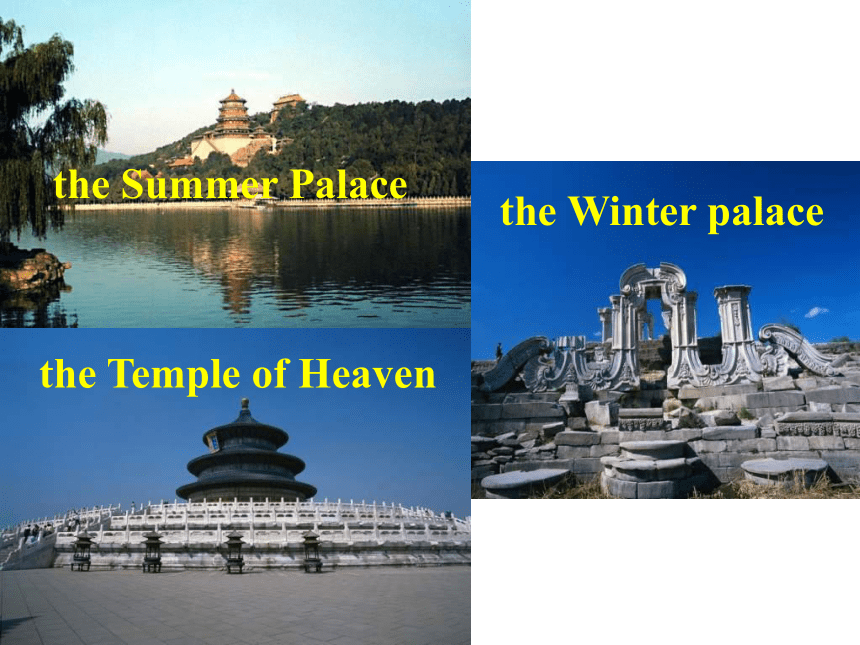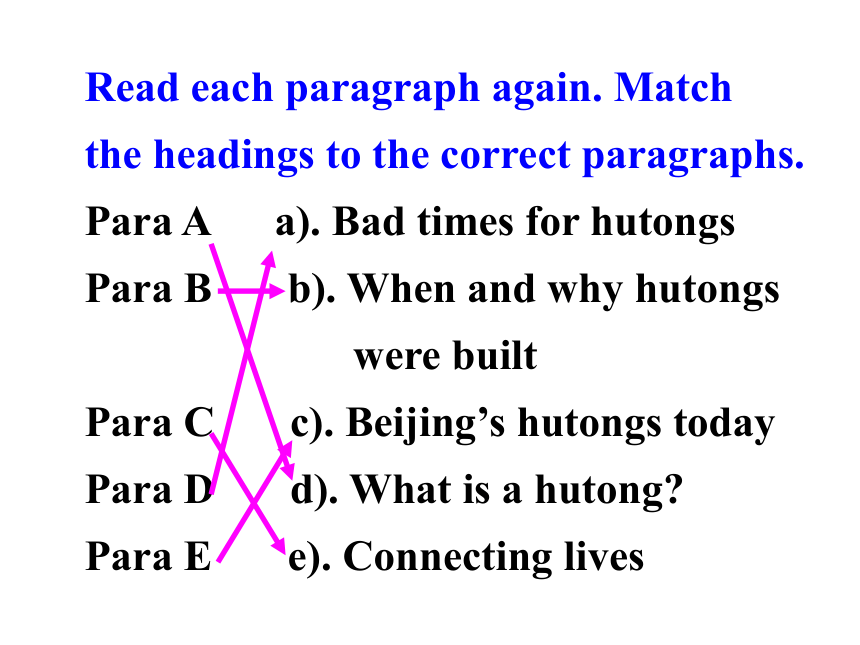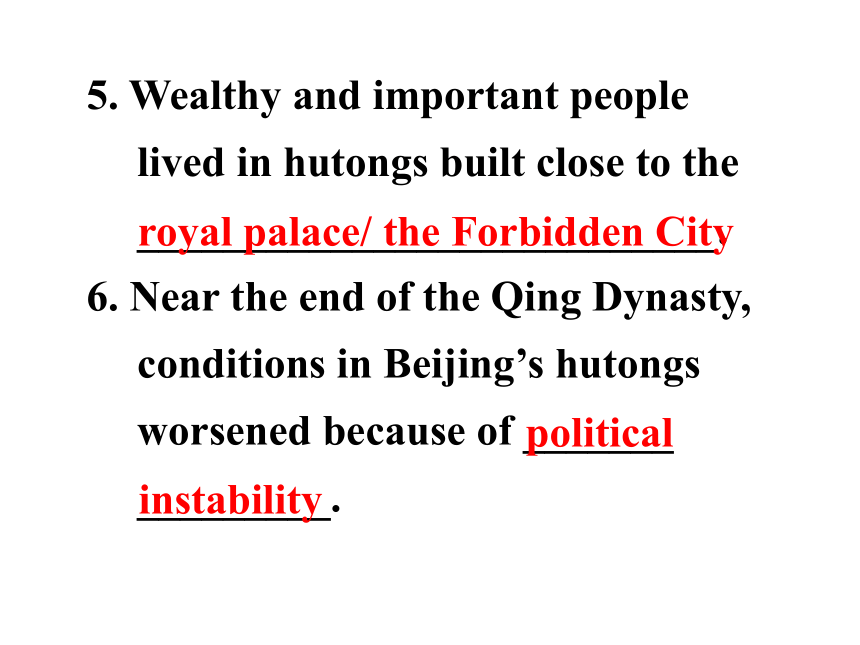英语高二下北师大版Unit24《Society》(Lesson 3)课件
文档属性
| 名称 | 英语高二下北师大版Unit24《Society》(Lesson 3)课件 |

|
|
| 格式 | zip | ||
| 文件大小 | 677.0KB | ||
| 资源类型 | 教案 | ||
| 版本资源 | 北师大版 | ||
| 科目 | 英语 | ||
| 更新时间 | 2013-03-11 21:02:00 | ||
图片预览












文档简介
课件38张PPT。A Changing WorldLesson 3PredictingLook at the photos and the title, and predict where these people lived and what the article is about. Tiananmen Squarethe Imperial Palace/
the Forbidden City the Summer Palacethe Winter palacethe Temple of HeavenHave you ever visited some Hutongs in Beijing?SiheyuanRead the text to get the general idea and identify paragraph topics.
Underline the key sentence in each paragraph (often the beginning but not always). Then find information that backs it up.
Write notes of the main points and the key information. Use your own words.Reading Stragetegies: Summarisinga). Beijing Urban Planning
b). Chinese Buildings
c). Beijing’s Hutongs
d). The History of HutongsRead the article quickly and check your prediction. Then choose the best title for the article from the list below.Para A a). Bad times for hutongs Para B b). When and why hutongs
were built
Para C c). Beijing’s hutongs today
Para D d). What is a hutong?
Para E e). Connecting lives Read each paragraph again. Match the headings to the correct paragraphs.Hutongs are _________ that connect the court-yards of traditional Chinese houses.
2. The term hutong is nowadays used to describe the alleyways, courtyards and the ___________ that live there.alleywayscommunitiesNote-taking3. The Emperors organised Beijing in blocks of houses because this made the city easier to ____________ _________.
4. Most of Beijing’s hutongs were built during the _____ _____ and _____ Dynasties. be controlled/ supervised YuanMingQing5. Wealthy and important people lived in hutongs built close to the ___________________________.
6. Near the end of the Qing Dynasty, conditions in Beijing’s hutongs worsened because of _______ _________.royal palace/ the Forbidden City political instability7. After the People’s Republic of China was established, conditions in Beijing’s hutongs _________.
8. Today, _________ of Beijing’s residential areas are hutongs.
9. Today, ____ of Beijing’s population still lives in hutongs.improvedone thirdhalf10. Hutongs are still an important part of Beijing.
They attract many _______ each year. touristsWork in groups. Retell the text to each other using the notes from Exercise 5.
Try to use your own words and the headings below. SpeakingWhat is a hutong?When and why hutongs were built?Connecting livesBad times for hutongsBeijing’s hutongs todayVocabularyReplace the underlined words in the sentences with the words below.When I saw my teacher coming I hastily put my comic away.
2. Behind the hospital there is an alleyway filled with boxes.quicklya lanelocated, fixed up, quickly, worsened, a lane, most, join3. Those wires connect the TV to the DVD player.
4. He renovated the apartment before he moved in.
5. Her condition deteriorated suddenly and we feared she might die.joinfixed upworsened6. The majority of the students wanted to visit Beijing.
7. The city was situated in the north, between two rivers.MostlocatedUse the words and phrases in the box to complete the sentences.keep an eye on, glimpse, preserve,
narrow, squeeze, network, heartache,
courtyard, maintain, gazeShe saw the little dog _________ through the ______ gap in the fence.squeezingnarrow2. It’s important to _______ the natural environment.
3. I told your father I would _____________ you so you had better work hard!
4. Careers Offices ________ contact with young people when they have left school.keep an eye onmaintainpreserve5. The businessman had a _______ of contacts with whom he did business.
6. He likes to sit in the _________ and read his newspaper.
7. This situation will only lead to _________.heartachenetworkcourtyard8. He stopped talking suddenly and _____ into the distance.
9. He caught a _______ of a slightly embarrassed but charming smile.gazedglimpseLanguage Points1. flock
vi. (常与to, together连用)聚集成群
People in the town flocked to the
theatre to see the new opera.镇上的人蜂拥到剧院去看那部新歌剧Birds of a feather flock together.一丘之貉 flock n. 禽群;畜群
a flock of sheep 一群羊2. wander
vi.(常与in, off连用)漫游;漫步;漂泊
The children wandered in the woods.孩子们在森林里漫步。
The river wanders through beautiful country. 那河蜿蜒流过美丽的村庄。His mind is wandering. 他神志不清。3. gaze vi.
(常与at, into, on连用) 凝视,注视
The child gazed at the toys in the shop window. 孩子眼睛盯着商店橱窗里的玩具。He just sat gazing into space/gazing through the window. 茫然地望着/呆呆地望着4. in awe 敬畏地
No difficulty could awe these young men.
We felt awe when contemplating(欣赏) the works of Bach.
be in awe of对...望而生畏;对...感到害怕;对...十分崇敬
5. see sights 观光
6. leave….impression7. refer -rr- (常与to 连用)涉及; 提到
Don’t refer to this matter again, please.
The new law does not refer to farm land. 新法律与耕地无关。
The shop referred the complaint to the manufacturers.商店把投诉转交给制造商。
control over 控制
9.keep an eye on sb/sth: make sure that sb/sth is safe, etc; look after sb/sth
Keep an eye on the baby.
Could you keep an eye on my suitcase for a moment ?
10. be situated in/on adj. 坐落的, 位于的
The house is situated on a hill.
11. due to 因为;由…引起;由于
Many accidents are due to driving at high speed.
Her illness was due to bad food.
她的病是坏了的食物造成的。12. make up
One hundred years make up a century.
made up an excuse.
make up the lost time.
make up a room.构成编造补足收拾好13. be fascinated by: be attracted by14. date back (to/from)
This castle dates from the 14th century.
This castle dates back 6 centuries.
Our partnership dates back to 1960.15. an ancient yet modern city
a beautiful and tender lady
an ugly yet tender lady
Homework Write an article (100 words) about an ancient building of your hometown.
Remember to include a title and the most important information about the building.Filling the blanks. Hutongs are a ______ of ancient Chinese architecture. Nowadays, the word “ hutong” has come to mean more than just the _________ that connect the courtyards. It also refers to the _________ themselves and even to the ___________ that live there. featurealleywayscourtyardscommunities The ________ of Beijing’s hutongs were built between the 13th and 19th centuries during The Yuan, Ming and Qing Dynasties to help the Emperors _______________ over the city. majoritymaintain control By connecting people’s homes, the hutongs in fact _________ people’s lives. Because of the hutongs, courtyards were joined together for miles around creating a _______of people working, playing and living together ---a real __________.connectednetworkcommunity Towards the end of the Qing Dynasty, China’s ________ suffered due to political _________and the conditions in Beijing’s hutongs ___________. After the establishment of the People’s Republic of China, conditions _________ a great deal and many of the original hutongs were _________ and _________. economyinstabilitydeterioratedimprovedrenovatedpreserved Hutongs are still an _______ part of Beijing life. They not only ____ Beijing’s streets and communities but also its past and present, showing that Beijing is truly an ancient ___ modern city.integrallinkyetINDEX
the Forbidden City the Summer Palacethe Winter palacethe Temple of HeavenHave you ever visited some Hutongs in Beijing?SiheyuanRead the text to get the general idea and identify paragraph topics.
Underline the key sentence in each paragraph (often the beginning but not always). Then find information that backs it up.
Write notes of the main points and the key information. Use your own words.Reading Stragetegies: Summarisinga). Beijing Urban Planning
b). Chinese Buildings
c). Beijing’s Hutongs
d). The History of HutongsRead the article quickly and check your prediction. Then choose the best title for the article from the list below.Para A a). Bad times for hutongs Para B b). When and why hutongs
were built
Para C c). Beijing’s hutongs today
Para D d). What is a hutong?
Para E e). Connecting lives Read each paragraph again. Match the headings to the correct paragraphs.Hutongs are _________ that connect the court-yards of traditional Chinese houses.
2. The term hutong is nowadays used to describe the alleyways, courtyards and the ___________ that live there.alleywayscommunitiesNote-taking3. The Emperors organised Beijing in blocks of houses because this made the city easier to ____________ _________.
4. Most of Beijing’s hutongs were built during the _____ _____ and _____ Dynasties. be controlled/ supervised YuanMingQing5. Wealthy and important people lived in hutongs built close to the ___________________________.
6. Near the end of the Qing Dynasty, conditions in Beijing’s hutongs worsened because of _______ _________.royal palace/ the Forbidden City political instability7. After the People’s Republic of China was established, conditions in Beijing’s hutongs _________.
8. Today, _________ of Beijing’s residential areas are hutongs.
9. Today, ____ of Beijing’s population still lives in hutongs.improvedone thirdhalf10. Hutongs are still an important part of Beijing.
They attract many _______ each year. touristsWork in groups. Retell the text to each other using the notes from Exercise 5.
Try to use your own words and the headings below. SpeakingWhat is a hutong?When and why hutongs were built?Connecting livesBad times for hutongsBeijing’s hutongs todayVocabularyReplace the underlined words in the sentences with the words below.When I saw my teacher coming I hastily put my comic away.
2. Behind the hospital there is an alleyway filled with boxes.quicklya lanelocated, fixed up, quickly, worsened, a lane, most, join3. Those wires connect the TV to the DVD player.
4. He renovated the apartment before he moved in.
5. Her condition deteriorated suddenly and we feared she might die.joinfixed upworsened6. The majority of the students wanted to visit Beijing.
7. The city was situated in the north, between two rivers.MostlocatedUse the words and phrases in the box to complete the sentences.keep an eye on, glimpse, preserve,
narrow, squeeze, network, heartache,
courtyard, maintain, gazeShe saw the little dog _________ through the ______ gap in the fence.squeezingnarrow2. It’s important to _______ the natural environment.
3. I told your father I would _____________ you so you had better work hard!
4. Careers Offices ________ contact with young people when they have left school.keep an eye onmaintainpreserve5. The businessman had a _______ of contacts with whom he did business.
6. He likes to sit in the _________ and read his newspaper.
7. This situation will only lead to _________.heartachenetworkcourtyard8. He stopped talking suddenly and _____ into the distance.
9. He caught a _______ of a slightly embarrassed but charming smile.gazedglimpseLanguage Points1. flock
vi. (常与to, together连用)聚集成群
People in the town flocked to the
theatre to see the new opera.镇上的人蜂拥到剧院去看那部新歌剧Birds of a feather flock together.一丘之貉 flock n. 禽群;畜群
a flock of sheep 一群羊2. wander
vi.(常与in, off连用)漫游;漫步;漂泊
The children wandered in the woods.孩子们在森林里漫步。
The river wanders through beautiful country. 那河蜿蜒流过美丽的村庄。His mind is wandering. 他神志不清。3. gaze vi.
(常与at, into, on连用) 凝视,注视
The child gazed at the toys in the shop window. 孩子眼睛盯着商店橱窗里的玩具。He just sat gazing into space/gazing through the window. 茫然地望着/呆呆地望着4. in awe 敬畏地
No difficulty could awe these young men.
We felt awe when contemplating(欣赏) the works of Bach.
be in awe of对...望而生畏;对...感到害怕;对...十分崇敬
5. see sights 观光
6. leave….impression7. refer -rr- (常与to 连用)涉及; 提到
Don’t refer to this matter again, please.
The new law does not refer to farm land. 新法律与耕地无关。
The shop referred the complaint to the manufacturers.商店把投诉转交给制造商。
control over 控制
9.keep an eye on sb/sth: make sure that sb/sth is safe, etc; look after sb/sth
Keep an eye on the baby.
Could you keep an eye on my suitcase for a moment ?
10. be situated in/on adj. 坐落的, 位于的
The house is situated on a hill.
11. due to 因为;由…引起;由于
Many accidents are due to driving at high speed.
Her illness was due to bad food.
她的病是坏了的食物造成的。12. make up
One hundred years make up a century.
made up an excuse.
make up the lost time.
make up a room.构成编造补足收拾好13. be fascinated by: be attracted by14. date back (to/from)
This castle dates from the 14th century.
This castle dates back 6 centuries.
Our partnership dates back to 1960.15. an ancient yet modern city
a beautiful and tender lady
an ugly yet tender lady
Homework Write an article (100 words) about an ancient building of your hometown.
Remember to include a title and the most important information about the building.Filling the blanks. Hutongs are a ______ of ancient Chinese architecture. Nowadays, the word “ hutong” has come to mean more than just the _________ that connect the courtyards. It also refers to the _________ themselves and even to the ___________ that live there. featurealleywayscourtyardscommunities The ________ of Beijing’s hutongs were built between the 13th and 19th centuries during The Yuan, Ming and Qing Dynasties to help the Emperors _______________ over the city. majoritymaintain control By connecting people’s homes, the hutongs in fact _________ people’s lives. Because of the hutongs, courtyards were joined together for miles around creating a _______of people working, playing and living together ---a real __________.connectednetworkcommunity Towards the end of the Qing Dynasty, China’s ________ suffered due to political _________and the conditions in Beijing’s hutongs ___________. After the establishment of the People’s Republic of China, conditions _________ a great deal and many of the original hutongs were _________ and _________. economyinstabilitydeterioratedimprovedrenovatedpreserved Hutongs are still an _______ part of Beijing life. They not only ____ Beijing’s streets and communities but also its past and present, showing that Beijing is truly an ancient ___ modern city.integrallinkyetINDEX
